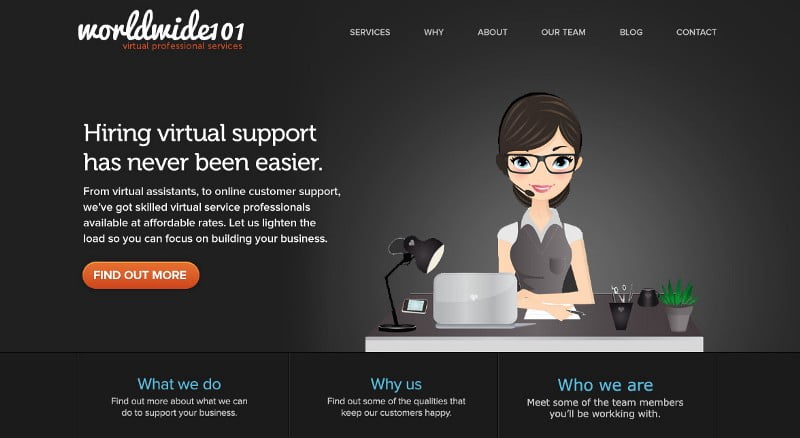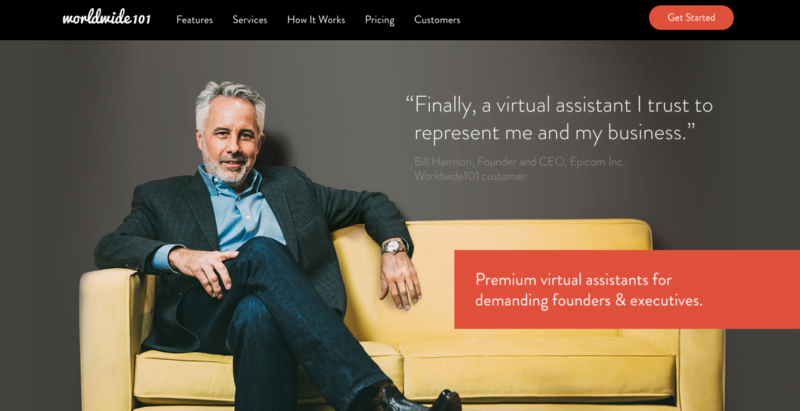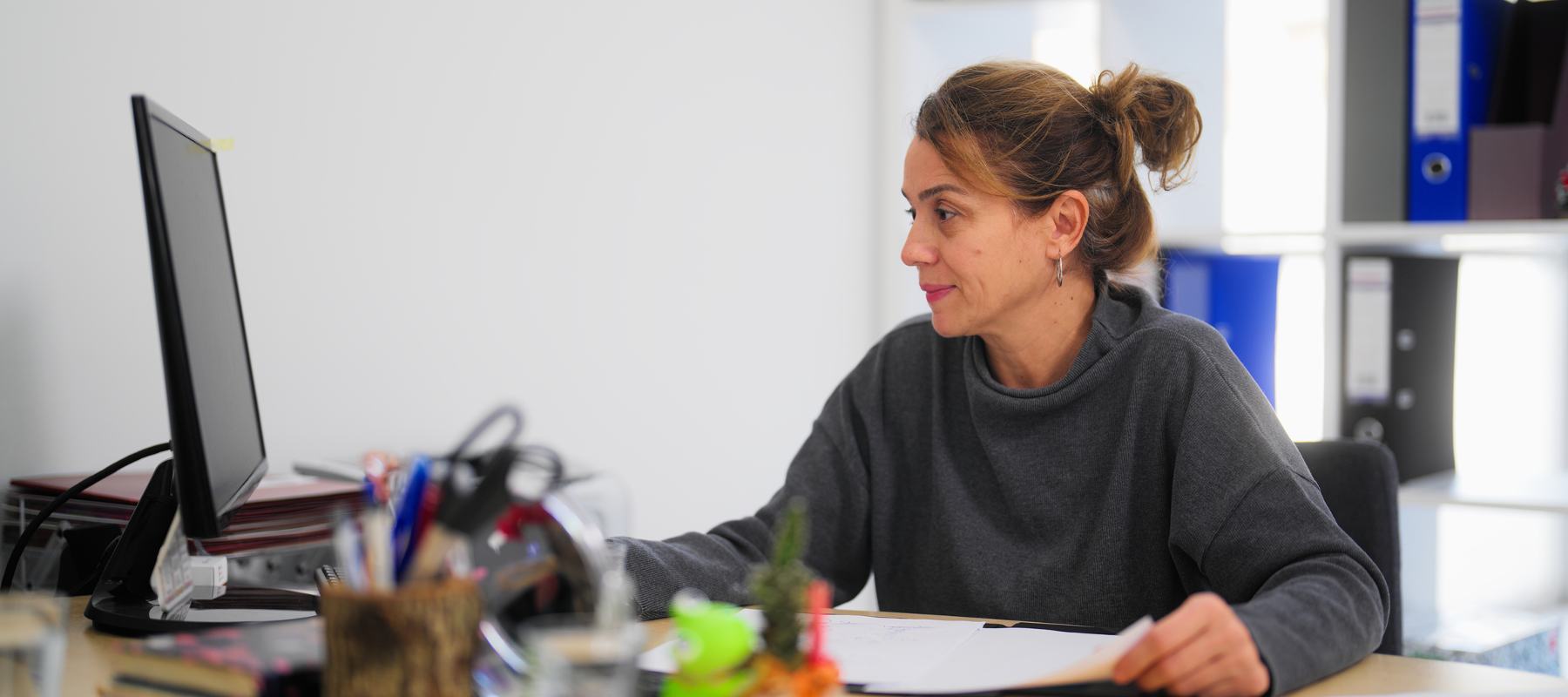If you’re an entrepreneur and haven’t read it yet, drop whatever you’re doing and check out Drift CEO David Cancel’s blog post, The Hypergrowth Curve: How to Navigate the 3 Stages of Massive Growth. According to Cancel, as startups scale, they go through three critical phases:
1. Discovery
See if your idea has legs
2. Mass production
Scale up after achieving product-market fit
3. Differentiation
Dominate a category or micro-niche
Sure enough, as I look back on growing Boldly, I can practically pinpoint the moments we made transitions between each of the stages Cancel identifies. In fact, you can see us move from one to the next simply by looking at how our home page — both the messaging and the design — evolved.
Stage 1: Discovery
I first got interested in the virtual assistant space because I wanted the freedom that came with working remotely. Soon, clients were asking me to source virtual help for their teams, and I decided to turn that into a business. I called it Boldly because our clients were already global, and the 101 said “easy” to me — as in Algebra 101. (Not everyone gets it, but it’s a great conversation starter!)
This was our very first homepage (2012):
At the time, our tiny team took on whatever back office admin help clients asked for, and I wanted our site to convey that it was easy to get started.
The website was a huge hit: within a year, our revenue doubled.
Stage 2. Mass production
While initial growth was a great validator of our idea, it laid bare the limitations of our “take all comers” approach. We were spending the bulk of our time accommodating clients with esoteric needs, and my team was miserable. If that continued, we could kiss continued growth goodbye.
So in 2014, I realized that, in order to scale, we would have to actively court professional business people whose needs were more predictable — the kind of clients who always wound up loving us, and whom we delighted in serving.
Unfortunately, our first attempt at a more professional, “businessy” home page was a complete disaster (early 2014):
Almost immediately, inquiries from potential clients plummeted. To find out why, I showed the page to people I knew, and — while it’s so obvious in hindsight — they told me they could no longer figure out what we were selling.
So I gathered our designers and coders and we locked ourselves in a room until we came up with images and text that expressed the essence of our offering. We wound up bringing back the assistant — swapping out the cartoon for a real person — and updating the messaging with a more concrete description of our business-focused services (late 2014):
The new page was a success, and very soon our rate of new-client acquisition jumped more than 80%. We were finally attracting the kinds of customers we knew we needed to scale.
Stage 3. Differentiation
By 2015, however, the virtual assistant industry got much more crowded. New competitors, small and large, seemed to pop up weekly, and some mirrored the messaging and images we used to describe our offering. Our annual growth was still over 65% and we received the top ratings on websites that ranked the players in our industry, but prospects suddenly started asking, “You sound great, but how are you different from X?”
Of course, all of this was a natural consequence of our success. We had proven there was a market and built a brand, and now others saw the opportunity. Suddenly we had to be a lot more strategic about our position in the market.
Around that time, Andy Raskin, the strategic messaging and positioning expert, appeared on our radar. Impressed by his articles about how to craft a differentiated, strategic story for your company, we flew to San Francisco and engaged him to help us do just that.
During a breakthrough weekend meeting, Andy led us through his framework, which included asking us to define our Promised Land — the happily-ever-after future that we could commit to making real for our customers. To articulate our Promised Land, Andy suggested we ask our customers a simple question:
How did Boldly change your life?
The answer we heard most often was that, before finding us, our clients had been desperate for a virtual assistant to help grow their businesses — yet deeply skeptical of finding someone they could trust to handle sales, marketing, and other crucial activities. In many cases, that skepticism was borne of experiences in which the behavior of an unskilled virtual assistant — sourced from one of our competitors — had cost them money or reputation. With Boldly, they told us, they had a VA with whom they could build a long-term relationship and whom they could trust to represent their businesses.
That became the Promised Land message that’s now on the top of our home page. It also meant narrowing our target — it wasn’t just any businessperson we wanted, but founders and executives who were demanding enough to appreciate our team’s training, professionalism, and dedication. So we removed the assistant in the hero section — along with all the claims about why we’re so great! — and replaced it with the image of one of our happy clients (thanks, Bill Harrison!) basking in the Promised Land:
Today we get many more leads from prospects who recognize themselves in Bill — not just men, by the way — and who want what Bill has. Now our calls with prospects are less about “Why should I choose you over X?” and more about “Oh my god, I am so glad I found you.” These prospects essentially show up on our doorstep seeking the differentiation we talk about.
A Logo That Reflects Who We’ve Become
I’ve often thought about changing our company name. I mean, it’s not super-obvious that Boldly is where you’d find premium virtual assistants. But our clients have come to know and love us by that name — and there’s that investment in SEO — so this year, I made the decision to embrace our name for the long haul, come what may.
That said, I recently looked at our logo and realized that it didn’t convey our commitment to premium service and personalized attention that we’ve become known for:
I also saw an opportunity to put an image representing our assistants back into our visual identity.
Here’s the new logo that Boldly is introducing today:
I hope the new design expresses the lessons we’ve learned about who we are, whom we help, and how we impact people’s lives. Of course, if the past is any guide, new strategic challenges await. David Cancel didn’t write about the fourth stage of massive growth, but whatever it is, I’m sure that my team and I will be learning from it.










